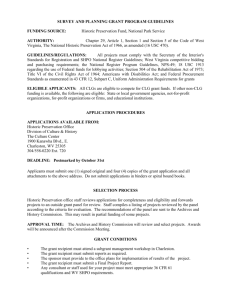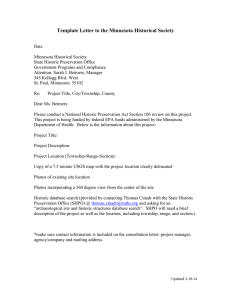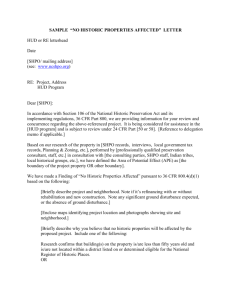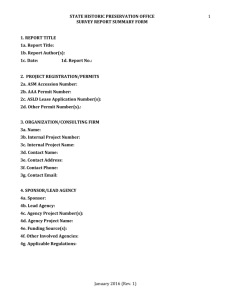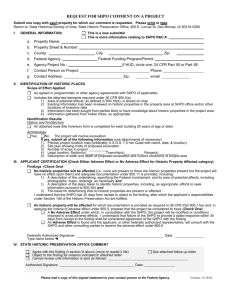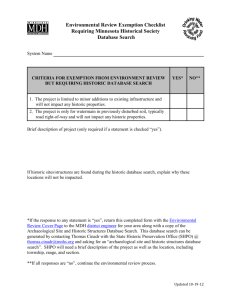The Certified Local Government program in NYS—Certification
advertisement
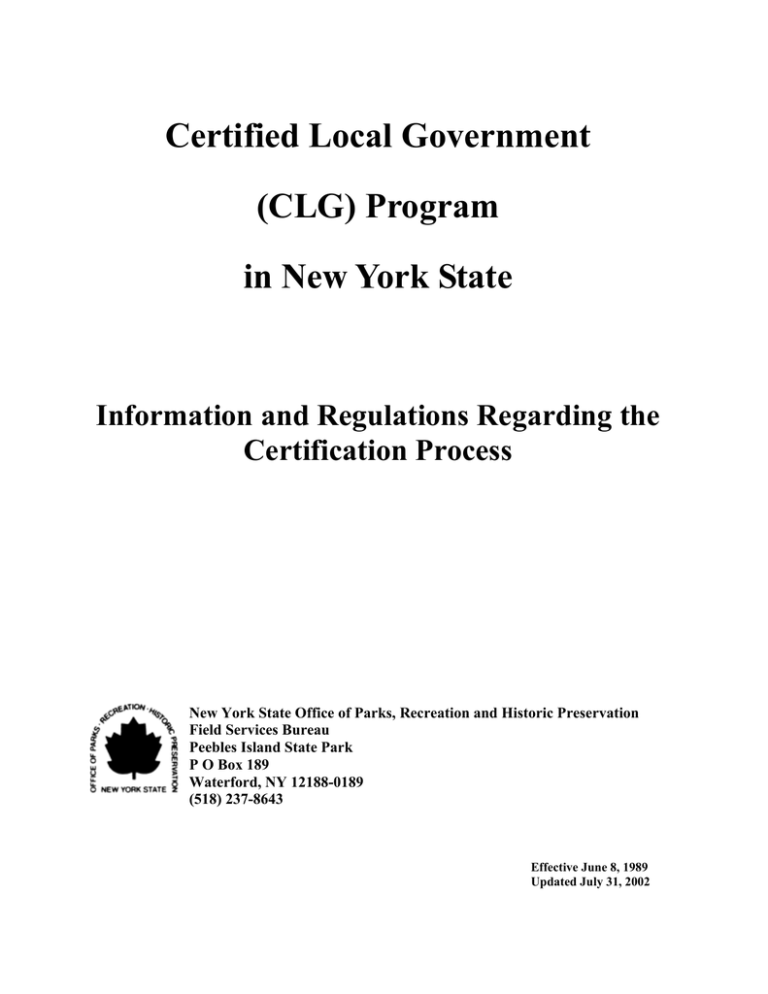
Certified Local Government (CLG) Program in New York State Information and Regulations Regarding the Certification Process New York State Office of Parks, Recreation and Historic Preservation Field Services Bureau Peebles Island State Park P O Box 189 Waterford, NY 12188-0189 (518) 237-8643 Effective June 8, 1989 Updated July 31, 2002 2 Table of Contents Section 1: Introduction and Purpose page 3 Section 2: Definitions page 4-5 Section 3: Requirements for Certification page 6-8 Section 4: Process for Certifying Local Governments page 9-10 Section 5: Responsibilities of Certified Local Governments page 11-15 Section 6: Process for Monitoring and Revoking Certification page 16 This publication has been financed in part with Federal funds from the National Park Service, U.S. Department of the Interior and administered by the New York State Office of Parks, Recreation and Historic Preservation. However, the information, contents and opinions do not necessarily reflect the views or policies of the Department of the Interior. In addition, under Title VI of the Civil Rights Act of 1964 and section 504 of the Rehabilitation Act of 1973, the U.S. Department of the Interior prohibits discrimination on the basis of race, color, national origin, or handicap in its federally assisted programs. If you believe you have been discriminated against in any program, activity of facility or in the information presented, or if you desire more information, please write to: Office of Equal Opportunity, National Park Service, 1849 C Street NW, Washington DC 20240. 3 Section 1: Purpose and Authority Congress established a preservation program for the United States with the National Historic Preservation Act of 1966. Since that time, the national historic preservation program has operated as a decentralized partnership between the federal government and the states with the common purpose of identifying, evaluating, and protecting the nation's historic properties. All preservation related programs are implemented primarily by the states through its State Historic Preservation Officers (SHPOs) whose authority was also established by the 1966 legislation. Recognizing the success of this relationship, Congress expanded the partnership to provide for participation by local governments. The 1980 amendments to the National Historic Preservation Act [16 U.S.C. 470a (7)(C)] contained the authorization in Section 101(a)(7)(C) for a federal-state-local preservation partnership that became known as the Certified Local Government (CLG) program. Federal law directs the Secretary of the Interior to certify qualified local governments through the authority delegated to the National Park Service. Working with the SHPO, the National Park Service specifies several requirements that local governments must meet to qualify for certification. Any municipality may request certification and the request is reviewed by the SHPO. Once the SHPO is satisfied that the municipality meets all requirements, a recommendation for certification is forwarded to the National Park Service. The procedures outlined in this handbook are part of the implementation of the federal-statelocal partnership in New York State by informing potential CLGs of the procedures and regulations required for participation in the program. 4 Section 2: Definitions The following definitions will apply throughout this document: A) Certified local government or CLG means any local government certified according to procedures in this document. CLG status is granted when a Certification Agreement is signed by both the SHPO and the chief elected official (CEO) of the local government after a review and with the concurrence of the National Park Service. B) Chief elected official (CEO) means the elected head of a local government. C) County means any county that is not wholly included within a city. D) Historic preservation review commission or the term commission means a board, council, commission, or similar body established by local historic preservation legislation and having the authority to carry out municipal responsibilities for a historic preservation program. If more than one local body has historic preservation responsibilities, the body having the responsibilities set forth in Section 3(a)(3) shall be considered the commission for purposes of the CLG program. E) Historic resource or historic property means any building, structure, district, landscape, area, site or object, including underground and underwater sites, that are of significance in the history, architecture, archeology, or culture of the state, its communities, or the nation. F) Legislation means the local law, ordinance, statute or other official action by the legislative body of the local government. G) Local government means a city, county, municipality, town or village, or any other general-purpose political subdivision of the state. H) National Park Service (NPS) means the bureau of the Department of the Interior through which the Secretary of the Interior administers the National Historic Preservation Program. 5 I) State Historic Preservation Officer or SHPO means the official within the state who has been designated and appointed by the Governor to administer the state historic preservation program. In New York, the SHPO is in the Commissioner of the Office of Parks, Recreation and Historic Preservation. SHPO may also refer to the State Historic Preservation Office, the bureau designated with historic preservation duties. J) Secretary means the Secretary of the United States Department of the Interior. K) Undertaking shall mean any of the following: 1) Any physical activity undertaken by a government agency, including the alteration or demolition of property, and the transfer, lease or sale of property. 2) The funding by a government agency of any physical activity, including the alteration or demolition of property, and the transfer, lease or sale of property. 3) The approval or entitlement by a government agency of any physical activity including the alteration or demolition of property, and the transfer, lease or sale of property. L) National Register of Historic Places means the national list of districts, sites, buildings, structures, landscapes, and objects significant in American history, architecture, archeology, engineering and culture maintained by the Secretary of the Interior. 6 Section 3: Requirements for Certification In order to qualify for certification, the local government must meet the following requirements: A) The local government must have and enforce local legislation for the designation and protection of historic properties enacted under the provisions of the New York State General Municipal Law Article 5, Section 96-a and 119aa-119dd. The following provisions must be included either in the local legislation or implementation regulations: 1) A statement of purpose; 2) The establishment of an historic preservation review commission; 3) Assignment of powers to the commission, which must include at least the power to: i) Designate or recommend designation of properties worthy of preservation; ii) Provide advice and guidance to property owners and government agencies concerning historic preservation issues; iii) Adopt rules for the conduct of commission business; and iv) In the case of cities, towns, and villages, the power to approve or disapprove any demolition, relocation, new construction, or exterior alteration affecting designated properties under its jurisdiction; v) In the case of counties, at least the power: (a) To review and comment upon all county undertakings and to recommend approval, modification, or disapproval of undertakings that might affect properties included in the county inventory or other historic properties. See Section 5.B.3(i)(c). (b) To review and report to the pertinent county agency or municipality whenever the county is called upon to formulate planning advice concerning actions that may affect properties included in the county inventory. 4) Provisions must include establishment of criteria and procedures for designation of historic properties worthy of preservation: i) Legislation encompassing all classes of historic properties is recommended; however, it is sufficient that the criteria admit at least one category of historic resources, such as historic districts, etc. 7 ii) The criteria may not exclude a class of resources that is defined solely in terms of the property's use or ownership, for example, religious properties, nor the actions of its owner such as designation subject to owner's consent. However, publicly owned properties that fall outside the commissions' ordinary jurisdiction may be explicitly or implicitly excluded. 5) The provisions must also include procedures for commission actions and standards and criteria for commission decisions that are consistent with the Secretary of the Interior's Standards for Archeology and Historic Preservation. The Standards can be accessed online at www.cr.nps.gov/local-law/arch_stnds_0.htm. 6) The provisions must also include procedures for enforcing commission decisions; and 7) A process for seeking relief from the strict application of the law in cases where unnecessary economic hardship can be proven; and 8) Other provisions to ensure due process, including notification procedures. B) The historic preservation review commission established by the local government must meet the following qualifications: 1) The commission must have no fewer than five members. 2) All commission members must have a demonstrated interest, competence or knowledge of historic preservation. 3) To the extent that such professionals are available, the community must appoint commission members to represent the disciplines of history, archeology, architecture, architectural history, and historic architecture. Members may also represent the fields of planning, folklore, cultural anthropology, conservation, landscape architecture, museums, and other historic preservation-related professions. 4) Terms of office must be staggered. 5) Commission meetings must be scheduled at regular intervals. 6) The jurisdiction of the commission must coincide with the geographical jurisdiction of the local government. 7) The commission must have at least the powers described in Section 3.A.3. C) The local government must maintain a system for the survey and inventory of historic 8 properties within its jurisdiction, and must be coordinated with and complementary to the survey activities of the SHPO. 1) To ensure that local survey and inventory data can be readily integrated into the statewide comprehensive historic preservation planning process and other appropriate planning processes, the local government must follow survey methods, standards and format established by the SHPO. Guidelines for survey are available from the SHPO. i) If the local government receives prior written approval from the SHPO, the local government may use some other survey system and format. ii) The survey system should include all classes and types of historic resources, not only those that may be subject to the commission's jurisdiction. 2) All inventory material must be securely maintained and must be accessible to the public; however, access may be restricted in the case of inventoried properties that might be damaged by unauthorized persons if its location were generally publicized. D) The local government must provide for adequate public participation in the local historic preservation program. 1) All meetings must be open to the general public, announced by public notice, and documented through the taking of minutes, which must record all decisions and the reasons for those decisions, as required under the NYS Open Meetings Law (articles 6 and 7 of chapter 47 of the Consolidated Laws--Public Officers Law). 2) All policies, procedures, and guidelines used by the local government or commission must be maintained in written form and be readily accessible to the general public. 9 Section 4: Process for Certifying Local Governments A) The local government shall make a formal request to the SHPO for certification. The request must include the following: 1) A request to participate in the CLG program, including an assurance of the local government's intent to enter into a certification agreement, signed by the chief elected official of the local government or that official's designee; 2) A copy of the local historic preservation legislation and any policies, procedures, or regulations that have been adopted for administering and enforcing the legislation; 3) Information on the membership of the commission, documenting each member's interest or expertise in fields related to historic preservation and a description of the appointment process. If the commission membership is not drawn from the professional disciplines defined in 36 CFR 61.6 and the Secretary's Professional Qualification Standards (history, archeology, architectural history, architecture, or historic architecture), the local government must document its efforts to obtain representation in such discipline(s) and its proposed mechanism for obtaining professional expertise when needed. See Section 5.B.2.iii. 4) A description of the survey system in use by the municipality, a chronology of past survey efforts, a listing of all properties included in the local inventory, and a listing of properties designated under the local legislation; 5) If available, a copy of the current local historic preservation plan or a statement describing the local preservation program; and 6) If applicable, a statement concerning additional historic preservation responsibilities that the local government agrees to undertake if certified. B) The SHPO shall review the local government's submission to determine if it fulfills the requirements outlined in Section 3. During the review process, the SHPO may request additional documentation necessary to evaluate the municipality's eligibility for certification. The SHPO shall respond to the chief elected official within sixty (60) days of receipt of an adequately documented application for certification. 1) If the SHPO determines that the municipality's historic preservation program fails to qualify, the SHPO will identify the deficiencies and suggest remedies. 10 2) If the SHPO determines that the local government meets the requirements for certification, the SHPO, in consultation with the municipality, will prepare an agreement listing the specific responsibilities the local government will assume when certified. C) The SHPO will forward documentation of the local government's eligibility for certification to the National Park Service along with the signed certification agreement and a request for NPS concurrence. If the request for concurrence cannot be affirmed as submitted, the NPS will notify the SHPO of deficiencies within 15 working days. If the NPS concurs with the SHPO recommendation, the date of the NPS concurrence shall be the effective date of certification. The NPS will notify the CLG of the concurrence, along with a copy to the SHPO. 11 Section 5: Responsibilities of Certified Local Governments A) All the responsibilities delegated to the certified local government shall be listed in the written certification agreement, which may be amended upon mutual agreement of both parties and the concurrence of the National Park Service. B) In order to maintain CLG status, the local government must perform certain responsibilities according to the performance standards specified below. In cases where the performance standard is not being met at the time of certification, the certification agreement shall specify a time period for meeting that standard. Responsibilities: 1) To enforce the local historic preservation legislation; i) The local legislation shall be enforced continuously and consistently. ii) Before amending the local legislation or implementing regulations, the local government shall consult with the SHPO. iii) Any amendments to the legislation enacted by the local government and any rules or related administration procedures shall be consistent with the requirements and intent of the CLG program. iv) The local government shall provide the SHPO with copies of any amendments or rules within 90 days of their enactment. 2) To maintain a qualified historic preservation review commission; i) An adequate commission shall be maintained at all times. Vacancies shall not be allowed to impair the commission's ability to take action for more than thirty days. ii) The local government shall make maximum effort to obtain professionals who meet the qualification standards set forth in 36 CFR 61.6 and the Secretary's Professional Qualifications Standards to fill any vacancies on the commission. At a minimum, commission members must demonstrate interest, competence or knowledge of historic preservation. The local government shall maintain records of the appointment process and shall submit a description of the recruitment process and qualifications of any newly appointed members to the SHPO. iii) When a commission reviews and comments on National Register nominations or other actions requiring evaluation by a professional in a discipline that is not represented on the commission, the commission shall obtain expertise in that area before rendering its decision. The commission may seek assistance from 12 universities, private preservation organizations, the SHPO, other review commissions or private consultants. The local government shall maintain records documenting that such professional advisors to the commission comply with the 36 CFR 61.6 and the Secretary's Professional Qualification Standards. iv) Commission members shall maintain or augment their knowledge through participation in historic preservation training at least annually or as provided by the SHPO. The SHPO will provide all local commissions with orientation materials and training pertaining to the roles and operations of federal, state and local historic preservation programs. Commission members may satisfy the training requirement through attendance at training provided by the SHPO or at other training approved by the SHPO. Unless otherwise stated, at least 75% of commission members must attend such training. v) The commission shall meet at least four times during each year. In order to ensure public participation, the commission shall conduct all business in a public manner, consistent with provisions of the NYS Open Meetings Law (articles 6 and 7 of chapter 47 of the Consolidated Laws--Public Officers Law). 3) To maintain a system for the survey and inventory of historic properties coordinated with and complementary to the survey activities of the SHPO; i) Local inventories shall include, at a minimum: (a) All properties in the municipality that have been listed in the State and National Registers of Historic Places, (b) All locally designated properties, and (c) In the case of counties, all county-owned properties that meet the National Register criteria for evaluation. Evaluation of county properties shall be undertaken in consultation with the SHPO. ii) Copies of local inventory shall be provided to the SHPO for inclusion in the statewide inventory of historic resources. iii) All inventory material shall be updated to reflect new historic information or significant changes in the condition or status of inventoried property as such information becomes available, but at least every five years. iv) Local inventory data shall be maintained in a manner that is accessible to the public and secure from physical damage or loss. 4) To provide for adequate public participation in the historic preservation program. 13 i) All local government meetings concerning historic preservation shall be open to the general public, announced by public notice, and documented through the taking of minutes, in compliance with the NYS Open Meetings Law (articles 6 and 7 of chapter 47 of the Consolidated Laws--Public Officers Law). ii) All local government records, policies, procedures and standards for the historic preservation program shall be maintained in written form and be readily accessible to the general public. iii) The local government shall inform its employees and officers of conflict of interest rules mandated by NYS General Municipal Law Article 18 Sections 801 and 802, and by the National Register Programs Guidelines (NPS-49) by means of a written code of conduct, oath of office, annual training, or other means. iv) The local government shall solicit and respond to public comment on all historic preservation issues that are of general public interest, including, but not limited to local district designations, State and National Register nominations and establishment of policies and procedures. 5) To actively participate in the process of nominating properties to the State and National Registers of Historic Places. i) Certified local governments may propose and sponsor nominations to the State and National Registers, but may not review and nominate properties directly to the National Register except as provided in 36 CFR 60.12 (Nomination appeals). Nominations developed and sponsored by CLGs shall be given priority for review by the New York State Board for Historic Preservation, provided they are developed in consultation with the SHPO and based upon a comprehensive local historic resources survey. ii) If any State or National Register nomination proposal received by the SHPO lies within the jurisdiction of a CLG, the SHPO shall transmit a copy of the fully documented nomination proposal to the local historic preservation review commission and the chief elected official for review and comment in no less than sixty days nor more than one hundred and twenty days prior to the scheduled review of the proposal by the State Board for Historic Preservation. iii) If a historic district is proposed, the CLG shall assist the SHPO in notifying property owners and/or conducting public information meetings at a time and place agreeable to the SHPO. iv) The commission, after providing a reasonable opportunity for public comment, shall prepare a report stating its opinion as to whether or not such property meets the criteria for listing in the State and National Registers. The report shall objectively evaluate the property in accordance with the National Register criteria for evaluation. Upon request, the SHPO shall provide guidance in 14 applying the National Register criteria. v) Within sixty (60) days of notice from the State Historic Preservation Officer, the chief elected local official shall transmit the report of the commission and his/her recommendation to the SHPO. The CLG comment period may be reduced by mutual agreement between the CLG and the SHPO, and will be eliminated when the CLG, as sponsor of a nomination, transmits its report and recommendation as part of the nomination package. vi) If the commission and the chief elected official agree that the proposed nomination does not meet the criteria for listing in the State and National Registers of Historic Places, the chief elected official will return the nomination materials along with the commission's report and his/her opinion to the SHPO. The chief elected official shall notify the commission, the property owner(s) and the public of this action. The SHPO shall take no further action regarding the National Register nomination unless an appeal is filed in accordance with 36 CFR 60.12. If such an appeal is filed, the SHPO shall place the nomination before the State Board for Historic Preservation at the earliest possible meeting. vii) For the purposes of the State and National Registers nomination process, the jurisdiction of a county CLG shall include only properties owned by the county. Only in the case of county-owned property shall the county CLG have the powers described in Section 5.B.5.vi previous. 6) To submit an annual historic preservation report. The report shall be submitted to the SHPO no later than November 15 and shall cover the period ending on the preceding September 30. The report shall follow a format prepared by the SHPO and shall include: i) A statement of the present status of historic preservation activities and land use or other regulations relating thereto as they are being administered within the reporting jurisdiction; ii) An identification and analysis of any problems or issues relating to the effectiveness of local development or administration of historic preservation plans and programs, including problems of funding and personnel requirements, procedural problems, enforcement problems, or any other issue; iii) A report on commission activities, which shall include, at a minimum, the number and types of cases reviewed, documentation on any new designations made, updated resumes for commission members, and minutes relating to consideration of National Register nominations; iv) A report on the status of inventory and survey, including a list of properties added to the local inventory, and copies of the inventory forms. 15 v) Copies of any documents published by the commission or CLG concerning the local historic preservation program. C) The SHPO may at his/her discretion and by mutual written agreement with the local governing body, delegate further responsibilities to the certified local government. 1) Either the SHPO or the local government may initiate expansion of CLG responsibilities at any time. 2) Such delegation will be executed in the written certification agreement. 3) It shall be the responsibility of the SHPO to establish criteria, qualifications, and performance standards for such additional responsibilities. 16 Section 6: Process for Monitoring Performance of Certified Local Governments and Revoking Certification A) The SHPO shall monitor CLG programs and at least every four years shall evaluate each certified local government to ensure that it is fulfilling its responsibilities as defined in these procedures and in the written certification agreement. B) The SHPO shall examine documents submitted by the CLG, including the annual reports, completion reports for any subgrants, inventory forms, any procedures and guidelines published by the certified local government, and any other public documents relating to administration of the local historic preservation program. In addition, the CLG shall make available any other records and materials that the SHPO may request, and the SHPO may attend meetings of the commission or take other action to learn about the operations of the certified local government. C) The CLG will be notified in writing of the results of the performance review, along with suggestions for improvement in its operations. D) If the SHPO determines that the CLG has failed to fulfill its responsibilities according to the performance standards set forth in Section 5 previous, the SHPO shall notify the certified local government in writing of this determination, documenting the areas that require correction, and advice and assistance on any steps that must be taken to correct the deficiency. The SHPO shall specify a time period within which improvement must be achieved. The CLG shall have no less than thirty (30) days nor more than one hundred twenty (120) days to implement the required improvements. E) If at the end of the allotted time the SHPO determines that sufficient improvement has not occurred, the SHPO may recommend to the National Park Service that the certification of the local government be revoked, citing specific reasons for the recommendation. F) Within thirty (30) days of receipt of an appropriately documented SHPO recommendation for revocation of certification, the NPS will notify the SHPO of any problems or additional time needed to review the recommendation. The local government will be decertified upon NPS concurrence with the SHPO recommendation. G) When a local government's certification is revoked, the SHPO shall so notify the local government. If the municipality is a subgrantee for HPF monies for an activity found deficient by the SHPO, the SHPO will conduct financial closeout procedures as specified in the National Register Programs Guidelines.
